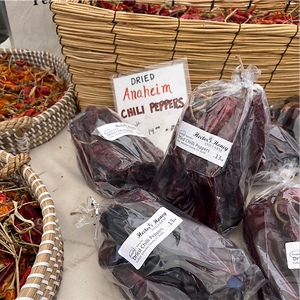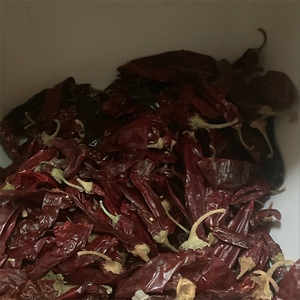


Dried Anaheim Chile Peppers
Estimated Inventory, 5 lbs : 5.38
This item was last sold on : 07/28/25
Description/Taste
Dried Anaheim chile peppers are a medium to large variety, averaging 12 and 15 centimeters in length, and have a flat and elongated, oval shape tapering to a point on the non-stem end. The dried peppers have a smooth and glossy appearance with deep folds and wrinkles, and the flesh is thin, ranging in color from burgundy, maroon, to dark red. Anaheim peppers may also be found dried in their early, green stage, displaying pale green to yellow hues, but the red version is the more common type. Underneath the leathery flesh, there are many small and round, dried yellow seeds encased within the pepper, but the seeds are often removed before cooking as they can impart a bitter flavor. Dried Anaheim chile peppers have a concentrated earthy, smokey, and sweet taste with a mild, acidic heat and faint fruity undertones.
Seasons/Availability
Dried Anaheim chile peppers are available year-round.
Current Facts
Dried Anaheim chile peppers, botanically classified as Capsicum annuum, are dehydrated versions of the Anaheim chile pepper, belonging to the Solanaceae or nightshade family. Fresh Anaheim peppers are utilized in culinary applications in their green, unripe stage, and red, mature stage, and the same principle can be applied to dried peppers, dehydrated in both green and red phases. Red Dried Anaheim chile peppers are the more commonly found version in local markets and grocers of the Southwestern United States and Northern Mexico, and the peppers are one of the mildest dried peppers available. Dried Anaheim chile peppers are also known by many other names, including California peppers, Colorado chiles, Seco del Norte, Chile Pasado, and Chile de la Tierra. The peppers are favored for their concentrated, sweet, and earthy flavor, and the dried peppers can be utilized in sauces, fillings, main dishes, and spices.
Nutritional Value
Dried Anaheim chile peppers are a source of vitamins A and C to strengthen the immune system, reduce inflammation, and protect the body from external environmental aggressors. The peppers also contain fiber to stimulate the digestive tract and lower amounts of iron, vitamin B6, potassium, and vitamin K.
Applications
Dried Anaheim chile peppers have a mild, subtle heat and a smokey-sweet flavor that can be incorporated into a wide array of applications. To rehydrate, the dried peppers should be soaked in hot water for 15 to 30 minutes. It is important to note that chefs often remove the seeds from the peppers as they can impart a bitter flavor. Some chefs slice the dried peppers and remove the seeds before rehydrating, while others remove the seeds after soaking. Regardless of the seed removal method, Dried Anaheim chile peppers will develop a fleshy, soft consistency once reconstituted that can be chopped and added to salsas, blended and mixed into sauces, or combined into fillings for tamales. The peppers can also be stuffed with cheese and baked, chopped into rice-based dishes, incorporated into soups and stews, added to marinades, sliced and mix into omelets, breakfast burritos, and fajitas, or thinly cut and slowly steeped in olive oil and garlic to make the fish dish known as pescado al ajillo. In Mexico, Dried Anaheim chile peppers are sometimes used in chile Colorado, a traditional stewed dish named after the red chile peppers mixed into the sauce. Beyond reconstituting, Dried Anaheim chile peppers can be toasted to develop a deeper flavor, ground into a powder, and used as a mild spice. Dried Anaheim chile peppers pair well with spices and herbs such as cumin, oregano, cilantro, and coriander, vinegar, aromatics such as onions and garlic, corn, legumes, tomatoes, avocado, citrus, zucchini, cheeses such as queso fresco, cheddar, or jack, and meats such as fish, pork, beef, and poultry. Dried peppers should be kept in airtight containers and stored in a cool, dry, and dark place for 1 to 2 years. It is advised to use the peppers within 3 to 6 months for the best quality and flavor.
Ethnic/Cultural Info
In New Mexico, Anaheim chile peppers are traditionally strung onto ristras, a grouping of peppers tied and hung in the air to dry. The word ristra means “string” in Spanish, and the strung pepper bunches have become a prominent symbol of hospitality in the American Southwest. Ristras are traditionally made in the early fall when the peppers are harvested, and the strands are left to dry into colorful, textured groupings. Once dry, ristras are hung in doorways, courtyards, and kitchens throughout New Mexico, and the pepper strands are believed to bring good luck and health while warding off evil. Ristras also provide a decorative storage method as the dried peppers will keep for an extended period, allowing home chefs to pull peppers off the bunch as needed for culinary applications. At the end of the pepper season, brightly colored ristras adorn roadside stands, tables at local markets, and walls of grocery stores, and many different varieties of peppers are used, with Dried Anaheim chile peppers being one of the mildest ristras available.
Geography/History
Anaheim chile peppers are native to New Mexico, where they were believed to have been developed from a local chile cultivar known as No. 9 at New Mexico State University. New Mexican horticulturalist Dr. Fabian Garcia intentionally bred the peppers to have a thicker flesh with a milder flavor. In 1894, Emilio Ortega encountered the peppers in New Mexico and brought them back to his home garden in Ventura, Southern California, where he eventually used the peppers in commercial canning. The peppers became increasingly popular across Southern California, leading the peppers to be named after the city of Anaheim in Orange County, California. Dried Anaheim chile peppers have been around since the Anaheim pepper's creation, and many home cooks dry the peppers to extend the pepper’s storage life. Today Dried Anaheim chile peppers are cultivated in hot and dry climates throughout the United States and are dried and sold through specialty grocers and local markets. The dried peppers are also utilized in culinary applications in Northern Mexico.
Featured Restaurants
Restaurants currently purchasing this product as an ingredient for their menu.
| Lauberge Del Mar | Del Mar CA | 858-259-1515 |
| Town & Country Main Storeroom | San Diego CA | 619-291-7131 |
| Zoya | La Jolla CA | 619-942-3396 |
| Marriott Del Mar | San Diego CA | 858-369-6029 |
| La Jolla Country Club | San Diego CA | 858-454-9601 |
| The Mission MB | San Diego CA | 858-488-9060 |
| Nolita Hall | San Diego CA | 619-618-8820 |
| Urban Kitchen Catering | San Diego CA | 619-276-8803 |
| Sandbar Sports Grill | San Diego CA | 858-488-1274 |
| Mission+Garnet | San Diego CA | 858-361-0870 |
| Wayfarer Bread | La Jolla CA | 805-709-0964 |
| Parkhouse Eatery | San Diego CA | 619 295 7275 |
Recipe Ideas
Recipes that include Dried Anaheim Chile Peppers. One









